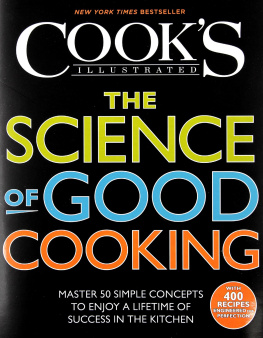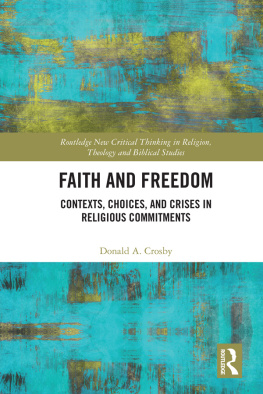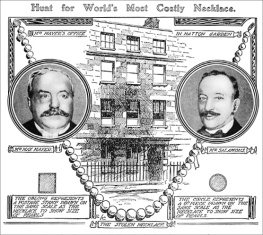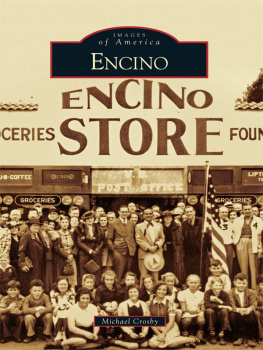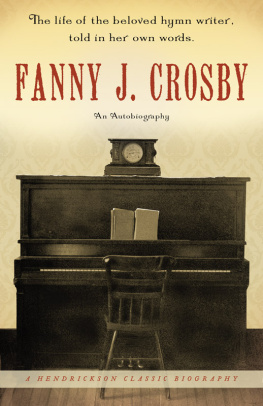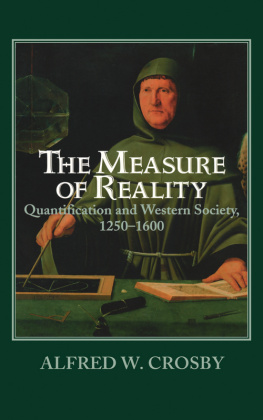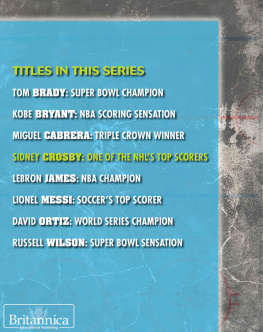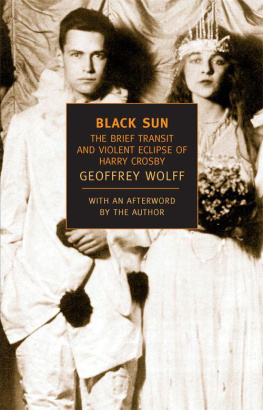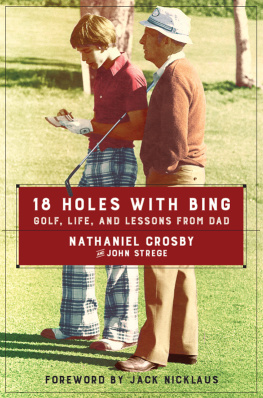A Body, Undone
Living On
after Great Pain

CHRISTINA CROSBY

NEW YORK UNIVERSITY PRESS
New York and London
www.nyupress.org
2016 by New York University
All rights reserved
References to Internet websites (URLs) were accurate at the time of writing. Neither the author nor New York University Press is responsible for URLs that may have expired or changed since the manuscript was prepared.
FOR LIBRARY OF CONGRESS CATALOGING-IN-PUBLICATION DATA,
PLEASE CONTACT THE LIBRARY OF CONGRESS.
ISBN: 978-1-4798-3353-5
New York University Press books are printed on acid-free paper, and their binding materials are chosen for strength and durability. We strive to use environmentally responsible suppliers and materials to the greatest extent possible in publishing our books.
Manufactured in the United States of America
10 9 8 7 6 5 4 3 2 1
Also available as an ebook
In memoriam
Jefferson Clark Crosby
Jane Miller Crosby
Kenneth Ward Crosby
Dedicated, with all my heart,
to Janet Jakobsen
After great pain, a formal feeling comes
The Nerves sit ceremonious, like Tombs
The stiff Heart questions was it He, that bore,
And Yesterday, or Centuries before?
The Feet, mechanical, go round
A Wooden way
Of Ground, or Air, or Ought
Regardless grown,
A Quartz contentment, like a stone
This is the Hour of Lead
Remembered, if outlived,
As Freezing persons, recollect the Snow
FirstChillthen Stuporthen the letting go
Emily Dickinson
CONTENTS
A BODY, UNDONE
1

Your Puny,
Vulnerable Self
On October 1, 2003, I caught a branch in the spokes of the front wheel of my bicycle, and hurtled toward the pavement. My chin took the full force of the blow, which smashed my face and broke the fifth and sixth cervical vertebrae in my neck. The broken bone scraped my spinal cord, and in an instant I was paralyzed. Theres no knowing right away exactly what impairments will result from a spinal cord injury, but as the days passed, it became clear that I had lost the use not only of my leg muscles, but also the muscles of my torso, arms, and hands, and that the loss of muscle compromised my bodys circulatory systems. I also lost control of my bladder and bowels. (The cord was not severed, so over many months I regained limited, but functional, strength in my arms and, to a significantly lesser degree, my hands.) Lying in the intensive care unit of Hartford hospital, I knew very little about the present and nothing about the future. I only knew that I had been grievously injured, and was lost in space. Not until I reached the rehab hospital a month after the accident could I begin to put into words a body that seemed beyond the reach of language.
The accident occurred twenty-nine days after my fiftieth birthday. Quadriplegia suddenly encountered at fifty years of age has made vividly clear to me both the vulnerability of the human body, and the
The weight of sudden spinal cord injury is crushing, and can at first be sustained only if spread out, as a suspension bridge spans great distances by hanging the roadway from cables that multiply as it reaches further across the void. Simply to save my life required the work of so manyfrom the EMTs who first tended my broken body, to all who in some way touched me over the next three and a half weeks of surgeries in Hartford Hospital. After five months of rehabilitation at the Hospital for Special Care, I was discharged to the care of one. Thats a standard used by the insurance companies to determine when you can be sent home. From that point onin principleI needed only one person to transfer me from bed to wheelchair and back again, to watch for pressure sores, to dress and undress me, to bathe me and brush my teeth, to feed me and help me drink, to help me relieve myself, and to purchase and administer my pharmacopeia of drugs. To keep me alive. The burden of my care was now to be transferred to private life, where one untrained person was charged with taking over. In most cases this would be a mother or wife. In my case the burden of my care came to my lover, Janet.
Janet and I had successfully spent a night together, alone, in an apartment set up in the Hospital for Special Care to test whether patients and their caretakers are able to manage on their own. Over forty-two weeks of rehabilitation, she had learned the routine of care, and had helped the overworked certified nurses assistants (CNAs) do their jobs. Our relationship scandalized no one, I think, because Janets help made everyones life easier. Lesbians were a-okay, or at least we were. That night she successfully cared for me in the apartmenttransferred me to the bed, undressed me, and did all the other necessary tasks. So on March 8, 2004, I was sent home with my lover. Thank God that Donna, a CNA who had cared for me at the hospital, accepted our offer of a second job working for us every weekday morning. She suggested that we hire her sister Shannon, also a CNA, to cover the weekends. I needed so much help. Janet needed so much help helping me. Whos to know what might have become of us had not Donna, Shannon, and a network of caring friends, colleagues, acquaintances, and others assisted us at every turn, and remained steadfast for the two years that I worked my way through outpatient physical and occupational therapies. So here I am, alive.
What does it take to make a life livable? Thats a slightly different matter, because it addresses the whole person, body and mindbodymindtogether. In 2005, I returned to work half-time, reassuming some of my duties as a professor of English literature and feminist, gender, and sexuality studies at Wesleyan University. My workplace has responded positively to my requests for reasonable accommodation, the terms of which are established by the Americans with Disabilities Act (ADA), comprehensive legislation that mandates the removal of barriers to participation in public life by those whose bodies are impaired or minds are nonnormativethe political victory won in 1992 by activists for disability rights. The university supported my recovery and continues to make good faith efforts to increase physical accessibility. I am remarkably fortunate that I can continue to do the work I did before I was injured, though Im able to work only half as many hours a week. Working is hard, but not working is harder. Engaging in the classroom, in my office talking with students and colleagues, reading and writing all take me out of myself, and distract me from chronic pain and incapacity. Its a hard truth that I hurt myself just when entering the peak earning years of my profession, which makes me angry every time I think of it. Nonetheless, with Janets income added to my reduced paycheck, I still have enough money to be insulated from the indignities of an unjust world in which so many disabled people suffer because their welfare depends on poorly paid personal aides sent out from agencies, public transportation that is often unreliable, and housing that is only barely or not at all accessible.
I now understand better what all disabled people owe to the early activists who demanded full access to and participation in the public sphere. Like all other civil rights law, the ADA was passed only after years of activismpeople in wheelchairs picketing for curb cuts, the Deaf President Now student movement at Gallaudet, lawyers suing school boards for the supports needed for disabled kids to learn alongside their peers, and so onand the activism that yielded the ADA was only a start. The struggle for recognition of discrimination against the handicapped now extends not only to the streets and courtrooms, but also to the classrooms of higher education. Scholars have convincingly argued that disability is not a personal attribute of crippled bodies or minds, but a social phenomenon that bars the full participation in public life of persons so impaired. Impassable barriers and narrowly conceived measurements of ability make it hard to acknowledge and address nonnormative bodyminds. We are conveniently invisible because we are all too often immured in private spaces. Disability is created by building codes and education policy, subway elevators that dont work and school buses that dont arrive, and all the marginalization, exploitation, demeaning acts, and active exclusions that deny full access and equality to the disabled. To focus on intractable pain, then, or grief at the loss of able-bodiedness, as I do here, may be thought to play into a pathologizing narrative that would return disability to misshapen bodies and abnormal minds. When I presented some of this work to a study group, one guy in a wheelchair more or less told me to man up and get on with my lifeafter all, thats what he had done decades ago, before the ADA, even.



